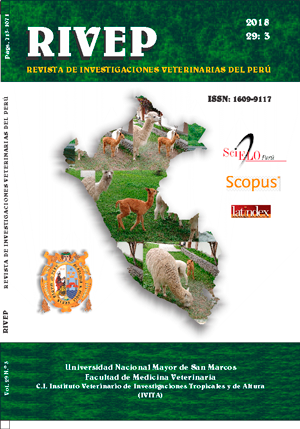Prevalence of chromosomal alterations in domestic dogs (Canis familiaris) with neoplasms: a prospective study
DOI:
https://doi.org/10.15381/rivep.v29i3.13235Keywords:
dogs, cytogenetic analysis, neoplasms, prevalenceAbstract
The objective of this study was to determine the prevalence of chromosomal alterations in Canis familiaris with clinical neoplasms. Twenty-five patients from a veterinary clinic in Lima, Peru in 2015-2016 were monitored. Blood samples were collected by venous puncture for peripheral blood culture and chromosomal analysis and were stored for 3 ± 1 hours maximum. Cytogenetic processing and conventional GTG banding were performed. The report was made according to the recommendations of the Committee for the Standardized Karyotype of the Dog. The average age was 9.5 years (4-17 years) and the racial groups with greater frequency were the mestizo (20%), Golden Retriever (16%) and Shi-tzu (11.5%). Chromosomal alterations were observed in 72% of the patients. Of these, 9 (36%) were trisomies, 9 (36%) constitutive heterochromatins, 2 (8%) translocations, 2 (8%) deletions and 1 (4%) ring chromosome. Mixed alterations were observed in 9 patients (36%), where the trisomy of chromosome 13 was the most frequent (28%), followed by heterochromatin of chromosome 9 (24%). Risk analysis using multiple logistic regression showed that dogs 10 years of age and older had 2.4 times more cancer risk than younger dogs (p<0.05).Downloads
Downloads
Additional Files
Published
Issue
Section
License
Copyright (c) 2018 Jeel Moya-Salazar, Mario Verano-Zelada, Rafael Vega-Vera

This work is licensed under a Creative Commons Attribution-NonCommercial-ShareAlike 4.0 International License.
AUTHORS RETAIN THEIR RIGHTS:
a. Authors retain their trade mark rights and patent, and also on any process or procedure described in the article.
b. Authors retain their right to share, copy, distribute, perform and publicly communicate their article (eg, to place their article in an institutional repository or publish it in a book), with an acknowledgment of its initial publication in the Revista de Investigaciones Veterinarias del Perú (RIVEP).
c. Authors retain theirs right to make a subsequent publication of their work, to use the article or any part thereof (eg a compilation of his papers, lecture notes, thesis, or a book), always indicating the source of publication (the originator of the work, journal, volume, number and date).



